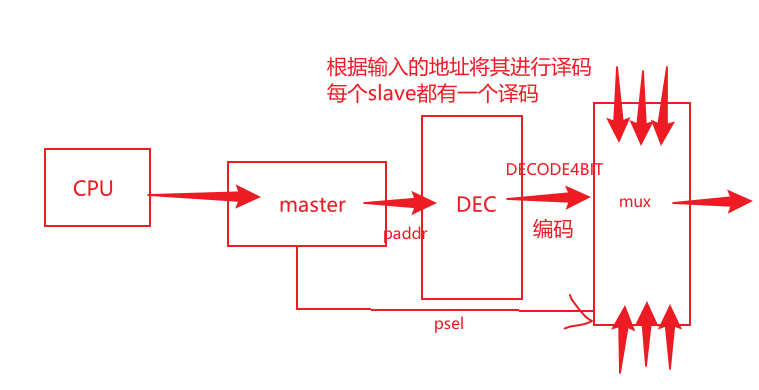基于APB slave mux我们可以快速地将多个apb slave连接在APB上面。在实际的设计当中都是采用这样的方式连接多个APB slave的

- DECODE4BIT - 可以理解为master接收到地址之后,进行译码,通过mux进行选择那个APB slave

module apb_slave_mux
#(
// 定义16个端口的使能信号,默认为1,保证每个slave端口信号能够输入
parameter PORT0_ENABLE = 1,
parameter PORT1_ENABLE = 1,
parameter PORT2_ENABLE = 1,
parameter PORT3_ENABLE = 1,
parameter PORT4_ENABLE = 1,
parameter PORT5_ENABLE = 1,
parameter PORT6_ENABLE = 1,
parameter PORT7_ENABLE = 1,
parameter PORT8_ENABLE = 1,
parameter PORT9_ENABLE = 1,
parameter PORT10_ENABLE = 1,
parameter PORT11_ENABLE = 1,
parameter PORT12_ENABLE = 1,
parameter PORT13_ENABLE = 1,
parameter PORT14_ENABLE = 1,
parameter PORT15_ENABLE = 1
)
(
// 选择信号
input wire [3:0] DECODE4BIT,
input wire PSEL,
// 每个slave的输入输出信号
output wire PSEL0,
input wire PREADY0,
input wire [31:0] PRDATA0,
input wire PSLVERR0,
output wire PSEL1,
input wire PREADY1,
input wire [31:0] PRDATA1,
input wire PSLVERR1,
output wire PSEL2,
input wire PREADY2,
input wire [31:0] PRDATA2,
input wire PSLVERR2,
output wire PSEL3,
input wire PREADY3,
input wire [31:0] PRDATA3,
input wire PSLVERR3,
output wire PSEL4,
input wire PREADY4,
input wire [31:0] PRDATA4,
input wire PSLVERR4,
output wire PSEL5,
input wire PREADY5,
input wire [31:0] PRDATA5,
input wire PSLVERR5,
output wire PSEL6,
input wire PREADY6,
input wire [31:0] PRDATA6,
input wire PSLVERR6,
output wire PSEL7,
input wire PREADY7,
input wire [31:0] PRDATA7,
input wire PSLVERR7,
output wire PSEL8,
input wire PREADY8,
input wire [31:0] PRDATA8,
input wire PSLVERR8,
output wire PSEL9,
input wire PREADY9,
input wire [31:0] PRDATA9,
input wire PSLVERR9,
output wire PSEL10,
input wire PREADY10,
input wire [31:0] PRDATA10,
input wire PSLVERR10,
output wire PSEL11,
input wire PREADY11,
input wire [31:0] PRDATA11,
input wire PSLVERR11,
output wire PSEL12,
input wire PREADY12,
input wire [31:0] PRDATA12,
input wire PSLVERR12,
output wire PSEL13,
input wire PREADY13,
input wire [31:0] PRDATA13,
input wire PSLVERR13,
output wire PSEL14,
input wire PREADY14,
input wire [31:0] PRDATA14,
input wire PSLVERR14,
output wire PSEL15,
input wire PREADY15,
input wire [31:0] PRDATA15,
input wire PSLVERR15
);
// 产生使能信号
wire [15:0] en = {
(PORT15_ENABLE ==1),
(PORT14_ENABLE ==1),
(PORT13_ENABLE ==1),
(PORT12_ENABLE ==1),
(PORT11_ENABLE ==1),
(PORT10_ENABLE ==1),
(PORT9_ENABLE ==1),
(PORT8_ENABLE ==1),
(PORT7_ENABLE ==1),
(PORT6_ENABLE ==1),
(PORT5_ENABLE==1),
(PORT4_ENABLE==1),
(PORT3_ENABLE==1),
(PORT2_ENABLE==1),
(PORT1_ENABLE==1),
(PORT0_ENABLE==1)
};
wire [15:0] dec = {
(DECODE4BIT == 4'd15),
(DECODE4BIT == 4'd14),
(DECODE4BIT == 4'd13),
(DECODE4BIT == 4'd12),
(DECODE4BIT == 4'd11),
(DECODE4BIT == 4'd10),
(DECODE4BIT == 4'd9),
(DECODE4BIT == 4'd8),
(DECODE4BIT == 4'd7),
(DECODE4BIT == 4'd6),
(DECODE4BIT == 4'd5),
(DECODE4BIT == 4'd4),
(DECODE4BIT == 4'd3),
(DECODE4BIT == 4'd2),
(DECODE4BIT == 4'd1),
(DECODE4BIT == 4'd0)
};
// PSEL0 - 表示输出的salve选择信号
// PSEL - 拉高表示master要选择一个slave
// en[0] - 对应端口使能,默认是为1
// dec[0] - 对应decode4bit编码值与相应的slave编码值一致
assign PSEL0 = PSEL & en[0] & dec[0];
assign PSEL1 = PSEL & en[1] & dec[2];
assign PSEL2 = PSEL & en[2] & dec[2];
//.......省略中间//省略3~15
assign PSEL15 = PSEL & en[15] & dec[15];
//省略3~15
assign PREADY = ~PSEL |
( dec[ 0] & (PREADY0 | ~en[ 0]) ) |
( dec[ 1] & (PREADY1 | ~en[ 1]) ) |
( dec[ 2] & (PREADY2 | ~en[ 2]) ) |
//....
(dec[15] & (PREADY15| ~en[15]));
//省略3~15
assign PSLVERR = ( PSEL0 & PSLVERR0 ) |
( PSEL1 & PSLVERR1 ) |
( PSEL2 & PSLVERR2 ) |
//...
( PSEL15 & PSLVERR15 ) ;
//省略3~15
assign PRDATA = ( {32{PSEL0 }} & PRDATA0 ) |
( {32{PSEL1 }} & PRDATA1 ) |
( {32{PSEL2 }} & PRDATA2 ) |
//...
( {32{PSEL15 }} & PRDATA15 ) ;
endmodule
- 根据PSEL是否有效以及DECODE4BIT的值,完成16选1,PSEL0~PSEL15有一个或者0个拉高。
- PREADYm默认为1,当PSEL为1的时候,根据译码结果选择相应的PREADY信号(当端口没有使能的时候en[x] == 0, 对应的PREADYx信号不会被选择)。
- PSLVERR和PRDATA,选中谁就取谁的